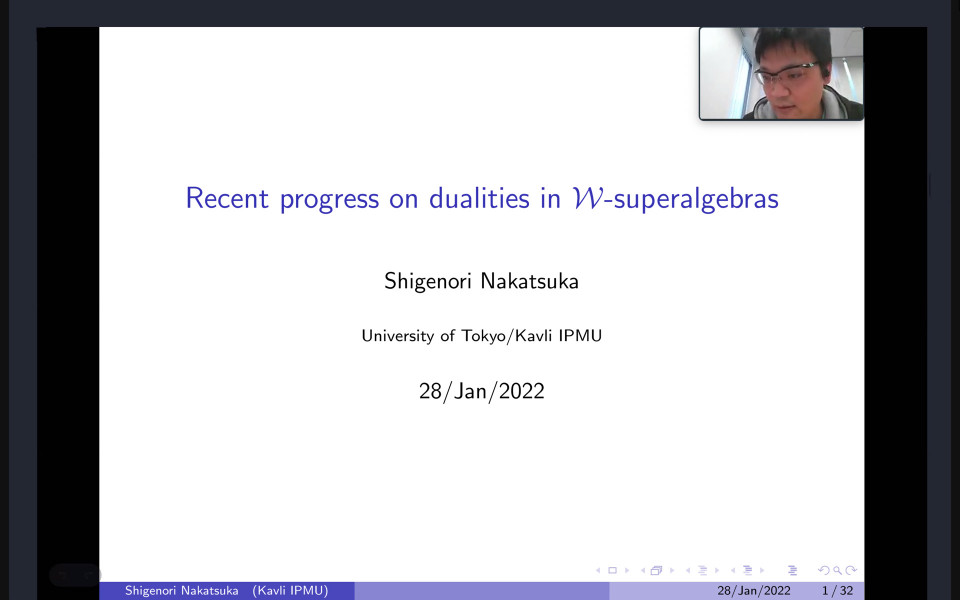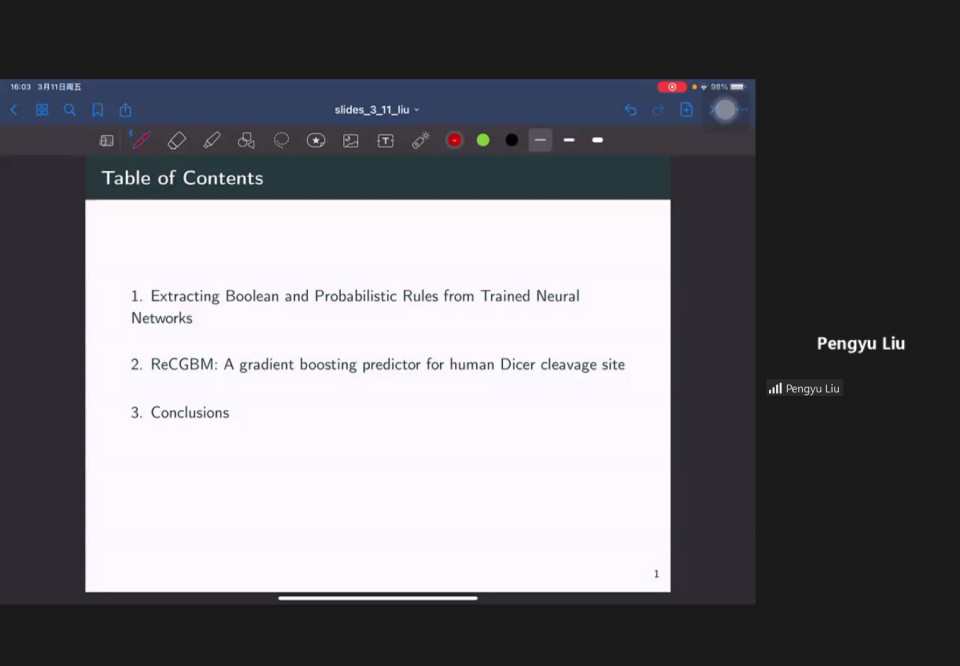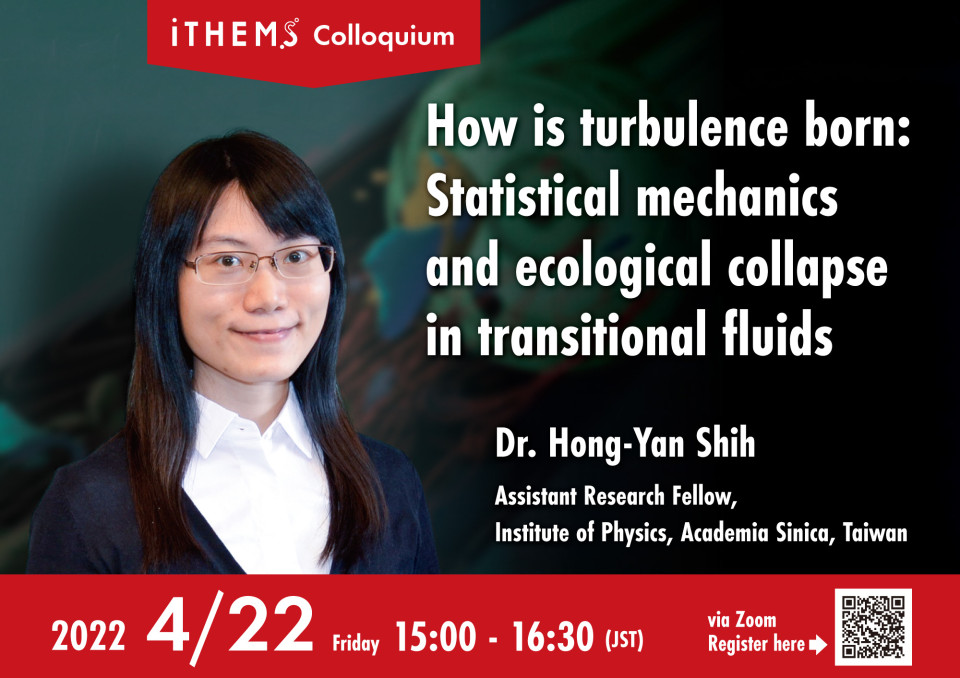Volume 190
Back to Newsletter List
Event Schedule
Events for the 4th week of March 2022
2022-03-17
Thursday, March 24, 17:00– 18:15 Quantum Matter Seminar
Friday, March 25, 9:30- 16:00 iTHEMS NOW & NEXT
Seminar Report
iTHEMS Math Seminar by Dr. Shigenori Nakatsuka on January 28, 2022
2022-03-15
Dr. Shigenori Nakatsuka from Kavli IPMU gave us a talk on dualities in W-superalgebras. In the first half of the talk he reviewed some basic concepts of vertex superalgebras, in particular W-superalgebras, and the Feigin--Frenkel duality, which states that the W-algebras in a certain class are isomorphic to the other W-algebras associated with the dual Lie algebras and the dual levels. In the latter half of the talk he introduced dualities beyond the Feigin--Frenkel duality including his recent work with Creutzig, Genra, and Sato. One of the remarkable results is the proof of the Feigin--Semikhatov conjecture, which gives a correspondence between the W-algebras associated with certain Lie algebras and the W-superalgebras associated with the corresponding Lie superalgebras. His talk was so stimulating that we could enjoy the mathematics of W-algebras.
Reported by Mizuki Oikawa
Recent progress on dualities in W-superalgebras
January 28 (Fri) 16:00 - 18:00, 2022
Seminar Report
iTHEMS Math Seminar by Dr. Pengyu Liu on March 11, 2022
2022-03-15
In March 11, there was a math seminar by Dr. Pengyu Liu from computational climate science research team. In the first part, he explained two extract rules to obtain Boolean function from the neural network. In the second part, he explained how we can apply results in the first part to predict human Dicer cleavage sites.
Reported by Keita Mikami
Extracting rules from trained machine learning models with applications in Bioinformatics
March 11 (Fri) 16:00 - 18:00, 2022
Upcoming Events
Seminar
iTHEMS Math Seminar
Explore the possibility to control hurricanes
March 18 (Fri) 16:00 - 18:00, 2022
Lin Li (Postdoctoral Researcher, Prediction Science Laboratory, RIKEN Cluster for Pioneering Research (CPR))
Hurricanes, also known as tropical cyclones and typhoons, are the biggest and the most devastating storms on Earth. In this seminar, I will talk about the possibility to control hurricanes with existing human capability. Energetically speaking, controlling hurricanes is a very challenging task due to a large gap: hurricanes are gigantic heat engines with a power of around 1014 Watt, while the most powerful manmade engines have the power of only 108 Watt. This six-order-magnitude gap is the major obstacle toward using existing engines to control hurricanes. To fill in this gap, we propose to utilize the chaotic nature of hurricanes, namely, the sensitivity of a chaotic system to its initial condition, to control hurricanes. In this presentation, I will first review the basics of hurricanes and existing chaos control methods, and then present my thoughts on hurricane control and preliminary results I acquired since joining Prediction Science Laboratory. Future directions on using reinforcement learning to control hurricanes will also be discussed. Since it is a very challenging task, I welcome any discussions, questions, and comments. I hope we can make the hurricane-risk-free future come earlier.
Venue: via Zoom
Event Official Language: English
Seminar
Quantum Matter Seminar
Local and global topology for Dirac points with multi-helicoid surface states
March 24 (Thu) 17:00 - 18:15, 2022
Tiantian Zhang (Specially Appointed Assistant Professor, School of Science, Tokyo Institute of Technology)
Though topological invariants defined for topological semimetals are usually local ones, they also have a global nature. For example, the Z type local monopole charge C for Weyl points, has a global nature, telling us its influence to the rest of the Brillouin zone, giving rise to bulk-surface correspondence associated with helical surface states. In Dirac systems, helical surface states are not guaranteed due to C=0. However, a new bulk-surface correspondence associated with double/quad-helicoid surface states (DHSSs/QHSSs) can be obtained for Dirac points with the protection of a Z2 type monopole charge Q, which is defined in terms of the time-reversal (T)-glide (G) symmetry (TG)2= -1. Here we study the topology of Q for Z2 Dirac points and establish its bulk-surface correspondence with strict proofs. We find that Q is equivalent to the G-protected Z2 invariant v mathematically and physically in Z2 Dirac systems. This result is counterintuitive, since v is always trivial in T-preserving gapped systems, and was thought to be ill-defined in gapless systems. We offer a gauge-invariant formula for Q, which is associated with DHSSs in both the spinless and spinful systems with single G. Q is formulated in a simpler form in spinless systems with two vertical G, associated with QHSSs, which is also entangled with filling-enforced topological band insulators in three space groups when a T-breaking perturbation is introduced. Since Q is ill-defined in spinful systems with two vertical G, QHSSs will not be held. Material candidate Li2B4O7 together with a list of possible space groups preserving QHSSs are also proposed for demonstration on our theory and further studies.
*Detailed information about the seminar refer to the email.
Venue: via Zoom
Event Official Language: English
Colloquium
iTHEMS Colloquium
How is turbulence born: Statistical mechanics and ecological collapse in transitional fluids
April 22 (Fri) 15:00 - 16:30, 2022
Hong-Yan Shih (Assistant Research Fellow, Institute of Physics, Academia Sinica, Taiwan)
The onset of turbulence is ubiquitous in daily life and is important in various industrial applications, yet how fluids become turbulent has remained unsolved for more than a century. Recent experiments in pipe flow finally quantified this transition, showing that non-trivial statistics and spatiotemporal complexity develop as the flow velocity is increased. Combining numerical simulations of the hydrodynamics equations and an effective theory from statistical mechanics, we discovered the surprising fact that fluid behavior at the transition is governed by the emergent predator-prey dynamics, leading to the mathematical prediction that the laminar-turbulent transition is analogous to an ecosystem on the edge of extinction. This prediction demonstrates that the laminar-turbulent transition is a non-equilibrium phase transition in the directed percolation universality class, and provides a unified picture of transition to turbulence in various systems. I will also show our recent progresses on transitional turbulence, including how an extended ecological model with energy balance successfully recapitulates the spatiotemporal patterns beyond the critical point, and the determination of the critical behavior and an emergent novel phase under interactions in the experimental collaboration.
Venue: via Zoom
Event Official Language: English
Paper of the Week
Week 3, March 2022
2022-03-17
Title: Universality of linear perturbations in SU($N$)-natural inflation
Author: Tomohiro Fujita, Kai Murai, Ryo Namba
arXiv: http://arxiv.org/abs/2203.03977v1
Title: New constraints on the neutron-star mass and radius relation from the terrestrial nuclear experiments
Author: Hajime Sotani, Nobuya Nishimura, Tomoya Naito
arXiv: http://arxiv.org/abs/2203.05410v1
Title: Neutron star mass formula with nuclear saturation parameters
Author: Hajime Sotani, Hajime Togashi
Journal Reference: Phys. Rev. D 105(6), 063010 (3/2022)
arXiv: http://arxiv.org/abs/2203.09004v1
If you would like to cancel your subscription or change your email address,
please let us know via our contact form.
Copyright © iTHEMS, RIKEN. All rights reserved.





